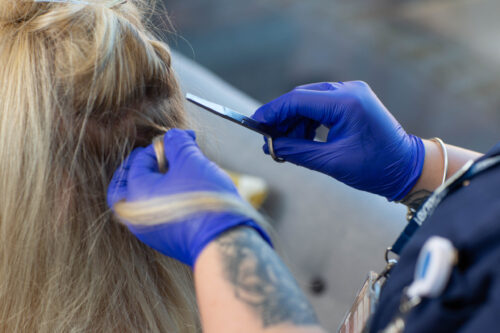
Chain of custody sample collection kit: important, intrusive or irrelevant?
By Allison Jones, Reporting Scientist.
The details we need and why.
In any hair drug test or hair alcohol test that we conduct, a sample will need to be provided by the individual. At the time of sample collection, the donor will be asked to provide certain details to the collector. This information is then recorded on the chain of custody sample collection kit associated with the sample collected.
Sometimes, a donor may feel that the questions asked at the time of sample collection are intrusive and/or irrelevant. Whilst we understand this, the information requested is important for many reasons, which are outlined below.
Sex at birth?
This question can offend some individuals as this can be very personal. We fully understand this, however, with regard to blood testing, the sex at birth question is important as certain blood alcohol markers have different cut off levels depending on sex at birth. Therefore, we need this information to ensure the results obtained are interpreted against the relevant cut off levels.
Natural hair colour?
This can help to identify if hair has been coloured/changed when assessing the hair sample and no declarations have been made.
Have any chemical hair treatments, such as dye or bleach, been used?
Chemical hair treatments can damage hair, having the potential effect of reducing the concentration of any drugs and metabolites and alcohol markers present in the hair. As such, this information is important when interpreting the results, as it could cause results to be lowered, or possibly be not detected at all.
Have any products been applied to the hair?
At Lextox, we test for two hair alcohol markers, ethyl glucuronide (EtG) and ethyl palmitate (EtPa). However, EtPa can be artificially elevated when an individual uses hair products containing ethanol, for example hairsprays and gels. Therefore, this information is important when assessing hair alcohol marker testing results.
We also ask if thermal straighteners have been used. This is because the use of thermal straighteners can affect the levels of some compounds in the hair.
If a hair drug screen is needed, we will ask if any substances been used and, if so, the date of last use (this refers to illegal substances). Often donors find this intrusive and don’t wish to incriminate themselves or declare any substance use. However, this information is pivotal in allowing us to state if such use could give rise to positive results and, importantly, if they can corroborate the donor’s declaration.
We also ask for details of any medications used. This information is important so that we can advise whether any medication the donor has used could cause a positive result.
In cases where alcohol testing is requested, we additionally ask for a donor’s approximate weekly alcohol consumption, as units of alcohol consumed per week. Whilst this can be difficult for a donor to estimate, there are eight tick box options to select from on the form, ranging from 0 to 52.5 + units per week (which equates to chronic excessive alcohol consumption). One unit is equivalent to approximately half a pint of average strength lager (4.0% ABV) or one single spirit measure (25ml) and a small glass of wine (125ml, 12% ABV) contains approximately one and a half units.

The hair alcohol test undertaken by Lextox is used to determine chronic excessive alcohol consumption over an approximate time period. However, the information provided by the donor allows us to comment on whether the declared consumption could account for the results obtained.
In summary, whilst the questions asked may seem intrusive and uncomfortable to answer, these questions are only asked as they are relevant and important for us to place the results in context with what has been declared.
If you would like further information on how we can support you, please get in touch here.
By Allison Jones
Reporting Scientist
Allison has a BSc with Honours in Forensic Science and has been with Lextox for seven years. Allison is a member of the Society of Hair Testing (SoHT) and specialises in the examination of hair samples for drugs of abuse, metabolites, and alcohol markers and the interpretation of these results. She has four years previous experience as a lead analyst in hair testing where she analysed and interpreted toxicological data from a number of hair cases using knowledge from the study of the medical/scientific literature and experience derived from casework. Additionally, she has successfully completed training in ‘Courtroom Skills for the Expert Witness’ and has attended court to provide expert evidence.
Published 05/04/24 – All information correct at time of publication





